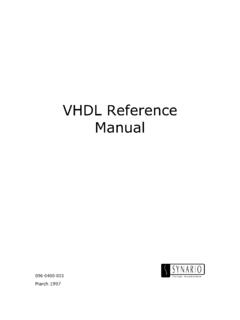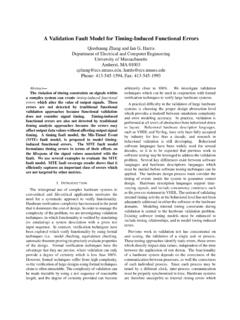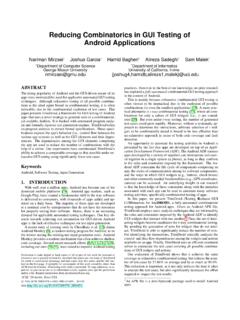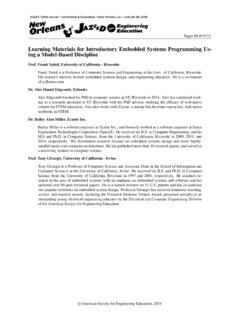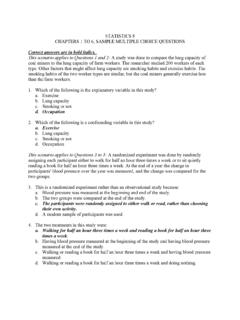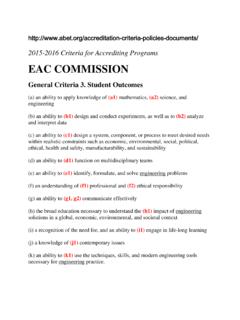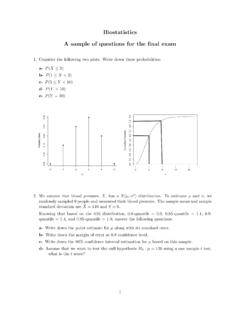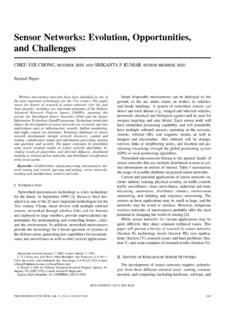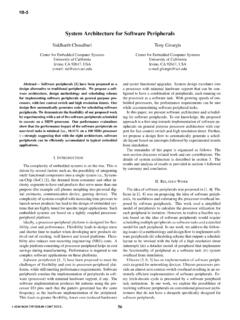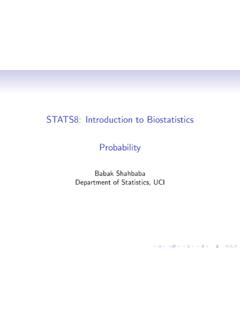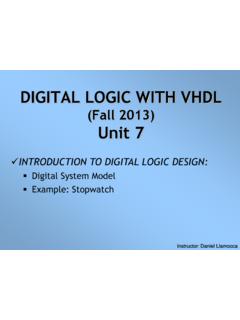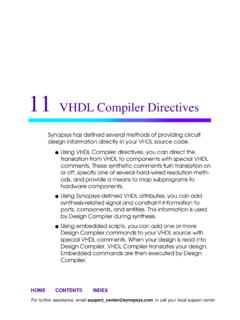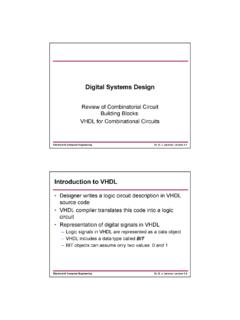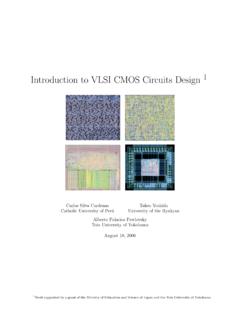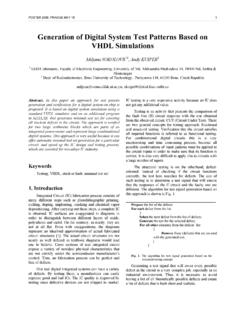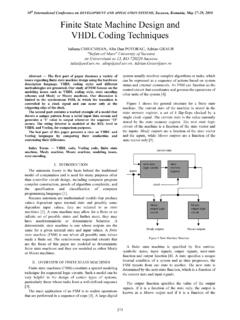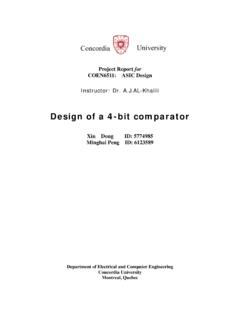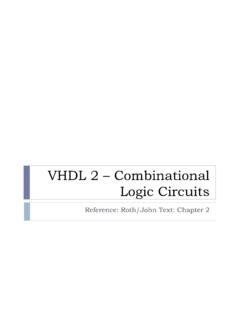Transcription of The VHDL Golden Reference Guide - University of California ...
1 TheVHDLG oldenReferenceGuideDOULOSDOULOSC hurch Hatch,22 Market Place, (+44) (0)1425 471223 Fax (+44) (0)1425 471573 Email Copyright 1995, Doulos, All Rights part of this publication may be reproduced, stored in a retrievalsystem, or transmitted, in any form or by any means, electronic,mechanical, photocopying, recording or otherwise, without theprior written permission of DOULOS. Printed in the UnitedKingdom of Great Britain and Northern , December 1995 The vhdl Golden Reference Guide is a compact quick referenceguide to the vhdl language, its syntax, semantics, synthesis andapplication to hardware vhdl Golden Reference Guide is not intended as a replacementfor the IEEE Standard vhdl Language Reference Manual.
2 Unlikethat document, the Golden Reference Guide does not offer acomplete, formal description of vhdl . Rather, it offers answers tothe questions most often asked during the practical application ofVHDL, in a convenient Reference is The vhdl Golden Reference Guide intended to be anintroductory tutorial. Information is presented here in a tersereference format, not in the progressive and sympathetic mannernecessary to learn a subject as complex as vhdl . However,acknowledging that those already familiar with computer languagesmay wish to use this Guide as a vhdl text book, a brief informalintroduction to the subject is given at the main feature of The vhdl Golden Reference Guide is that itembodies much practical wisdom gathered over many vhdl projects.
3 It does not only provide a handy syntax Reference ; there aremany similar books which perform that task adequately. It alsowarns you of the most common language errors, gives clues whereto look when your code will not compile, alerts you to synthesisissues, and gives advice on improving your coding vhdl Golden Reference Guide was developed to add value tothe Doulos range of vhdl training courses, and also to complementVHDL PaceMaker, the vhdl Computer Based Training packagefrom main body of this Guide is organised alphabetically. Each sectionis indexed by a key term which appears prominently at the top ofeach page. Often you can find the information you want by flickingthrough the Guide looking for the appropriate key term.
4 If that fails,there is a full index at the of the information in this Guide is organised around the vhdl syntax headings, but there are additional special sections on CodingStandards, design Flow, Errors, Reserved Words and vhdl 93, andalso listings of the standard packages Standard, TEXTIO,Std_logic_1164 and you are new to vhdl , you should start by reading A BriefIntroduction to vhdl , which follows IndexBold index entries have corresponding pages in the main alphabeticalreference section. The remaining index entries are followed by a listof appropriate page references in the main alphabetical referencesection, given in order of To Notation Used To Define vhdl SyntaxThe syntax definitions are written to look like examples whereeverpossible, but it has been necessary to introduce some extra brief, square brackets [] enclose optional items, three dots.
5 Meansrepetition, and curly brackets {} enclose comments. ItalicNamesrepresent parts of the syntax defined elsewhere. A full description ofthe notation follows:Curly brackets {} enclose comments that are not part of the vhdl syntax being defined, but give you further information about thesyntax enclosed in square brackets [] is optional (except in thedefinition of a signature, where square brackets are part of the vhdl syntax!).. means zero or more repetitions of the preceding item or line, ormeans a list, as follows:Item .. means zero or more repetitions of the Item., .. means repeat in a comma separated list ( A, B, C).; .. means repeat in a semicolon separated list.
6 | .. means repeat in a bar separated This GuideThere must be at least one item in the list. There is no , ; or | at theend of the list, unless it is given explicitly (as in ; .. ; ).Underlined syntax belongs to the vhdl '93 language, but not toVHDL'87. (For the sake of clarity, underlining has been omittedwhere words contain the underscore character.)words in lower case letters are reserved words, built into the vhdl language ( entity)Capitalised Words (not in italics) are vhdl identifiers, userdefined or pre-defined names that are not reserved identifiers ( , BlockLabel).Italic Words are syntactic categories, the name of a syntaxdefinition given in full elsewhere.
7 A syntactic category can be eitherdefined on the same page, defined on a separate page, or one of thetwo special categories defined = indicates a syntactic category which is defined and used onthe same syntactic categories:SomethingExpression = Expression, where the Something gives information about the meaning of the expression ( ).Condition = Expression, where the type of the expression is following paragraphs give a brief technical introduction toVHDL suitable for the reader with no prior knowledge of thelanguage. As will be evident from these paragraphs, vhdl uses a lota specialised technical jargon!BackgroundThe letters vhdl stand for the VHSIC (Very High Speed IntegratedCircuit) Hardware Description Language.
8 vhdl is a language fordescribing the behaviour and structure of electronic circuits, and isan IEEE standard (1076). vhdl is used to simulate the functionality of digital electroniccircuits at levels of abstraction ranging from pure behaviour down togate level, and is also used to synthesize ( automatically generate)gate level descriptions from more abstract (Register Transfer Level)descriptions. vhdl is commonly used to support the high leveldesign (or language based design ) process, in which an electronicdesign is verified by means of thorough simulation at a high level ofabstraction before proceeding to detailed design using automaticsynthesis became an IEEE standard in 1987, and this version of thelanguage has been widely used in the electronics industry andacademia.
9 The standard was revised in 1993 to include a number ofsignificant LanguageIn this section as in the rest of the Guide , words given in CapitalisedItalics are technical terms whose definitions may be found in themain body of this hierarchical portion of a hardware design is described in VHDLby an Entity together with an Architecture. The Entity defines theinterface to the block of hardware ( the inputs and outputs), whilstthe Architecture defines its internal structure or behaviour. An Entitymay possess several alternative is defined by means of Components, which are analogousto chip sockets. A Component is Instantiated within an Architecture torepresent a copy of a lower level hierarchical block.
10 The associationbetween the Instance of the Component and the lower level Entity andArchitecture is only made when the complete design hierarchy isassembled before simulation or synthesis (analogous to plugging achip into a chip socket on a printed circuit board). The selection of6A Brief Introduction To vhdl which Entity and Architecture to use for each Component is made inthe Configuration, which is like a parts list for the design structure of an electronic circuit is described by making Instancesof Components within an Architecture, and connecting the Instancestogether using Signals. A Signal represents an electrical connection, awire or a bus. A Port Map is used to connect Signals to the Ports of aComponent Instantiation, where a Port represents a Signal has a Type, as does every value in vhdl .
